1997 SSANGYONG KORANDO steering
[x] Cancel search: steeringPage 1497 of 2053
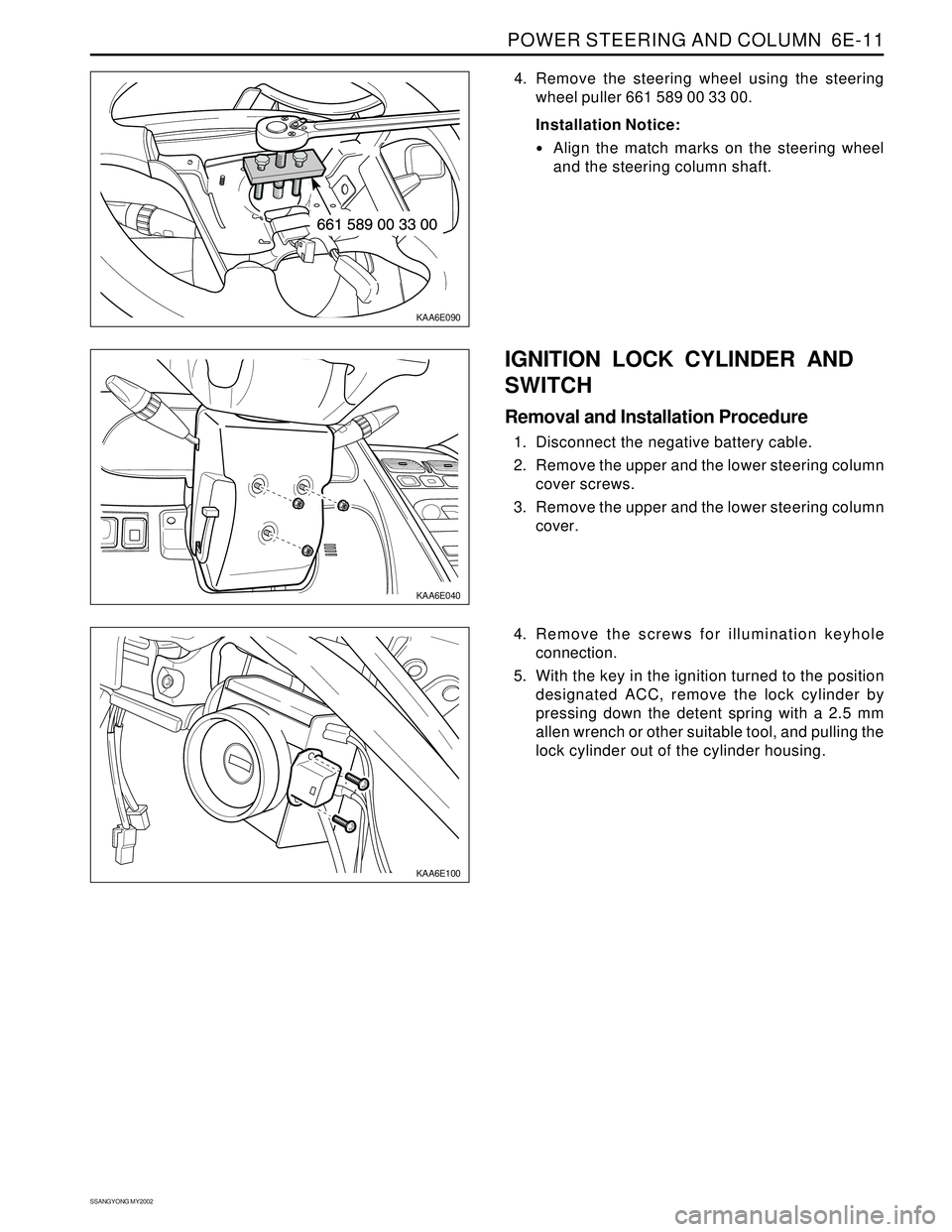
POWER STEERING AND COLUMN 6E-11
SSANGYONG MY2002
KAA6E040
KAA6E100
KAA6E090
4. Remove the steering wheel using the steering
wheel puller 661 589 00 33 00.
Installation Notice:
Align the match marks on the steering wheel
and the steering column shaft.
IGNITION LOCK CYLINDER AND
SWITCH
Removal and Installation Procedure
1. Disconnect the negative battery cable.
2. Remove the upper and the lower steering column
cover screws.
3. Remove the upper and the lower steering column
cover.
4. Remove the screws for illumination keyhole
connection.
5. With the key in the ignition turned to the position
designated ACC, remove the lock cylinder by
pressing down the detent spring with a 2.5 mm
allen wrench or other suitable tool, and pulling the
lock cylinder out of the cylinder housing.
Page 1498 of 2053
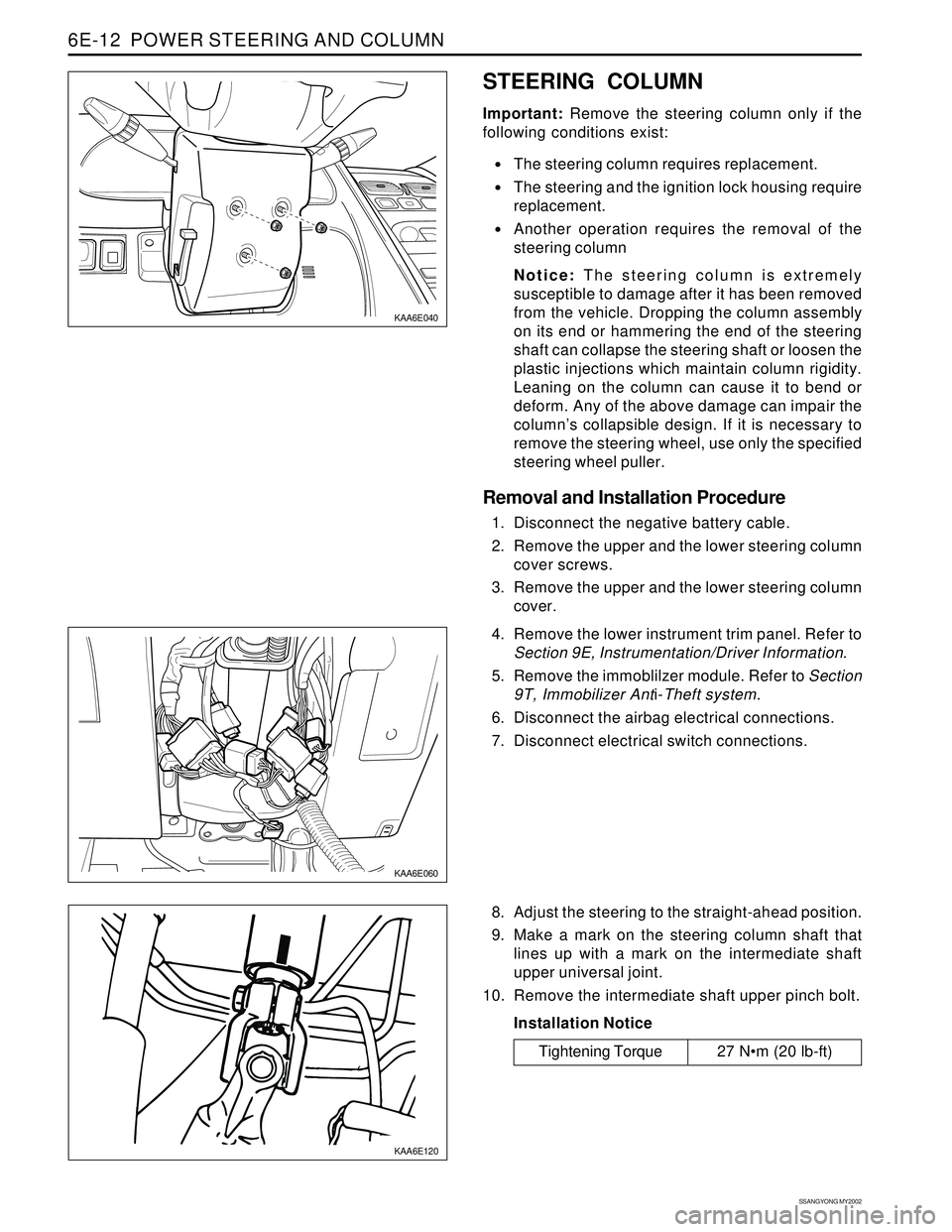
SSANGYONG MY2002
6E-12 POWER STEERING AND COLUMN
KAA6E040
KAA6E120
STEERING COLUMN
Important: Remove the steering column only if the
following conditions exist:
The steering column requires replacement.
The steering and the ignition lock housing require
replacement.
Another operation requires the removal of the
steering column
Notice: The steering column is extremely
susceptible to damage after it has been removed
from the vehicle. Dropping the column assembly
on its end or hammering the end of the steering
shaft can collapse the steering shaft or loosen the
plastic injections which maintain column rigidity.
Leaning on the column can cause it to bend or
deform. Any of the above damage can impair the
column’s collapsible design. If it is necessary to
remove the steering wheel, use only the specified
steering wheel puller.
Removal and Installation Procedure
1. Disconnect the negative battery cable.
2. Remove the upper and the lower steering column
cover screws.
3. Remove the upper and the lower steering column
cover.
KAA6E060
4. Remove the lower instrument trim panel. Refer to
Section 9E, Instrumentation/Driver Information.
5. Remove the immoblilzer module. Refer to Section
9T, Immobilizer Anti-Theft system.
6. Disconnect the airbag electrical connections.
7. Disconnect electrical switch connections.
8. Adjust the steering to the straight-ahead position.
9. Make a mark on the steering column shaft that
lines up with a mark on the intermediate shaft
upper universal joint.
10. Remove the intermediate shaft upper pinch bolt.
Installation Notice
Tightening Torque 27 Nm (20 lb-ft)
Page 1499 of 2053
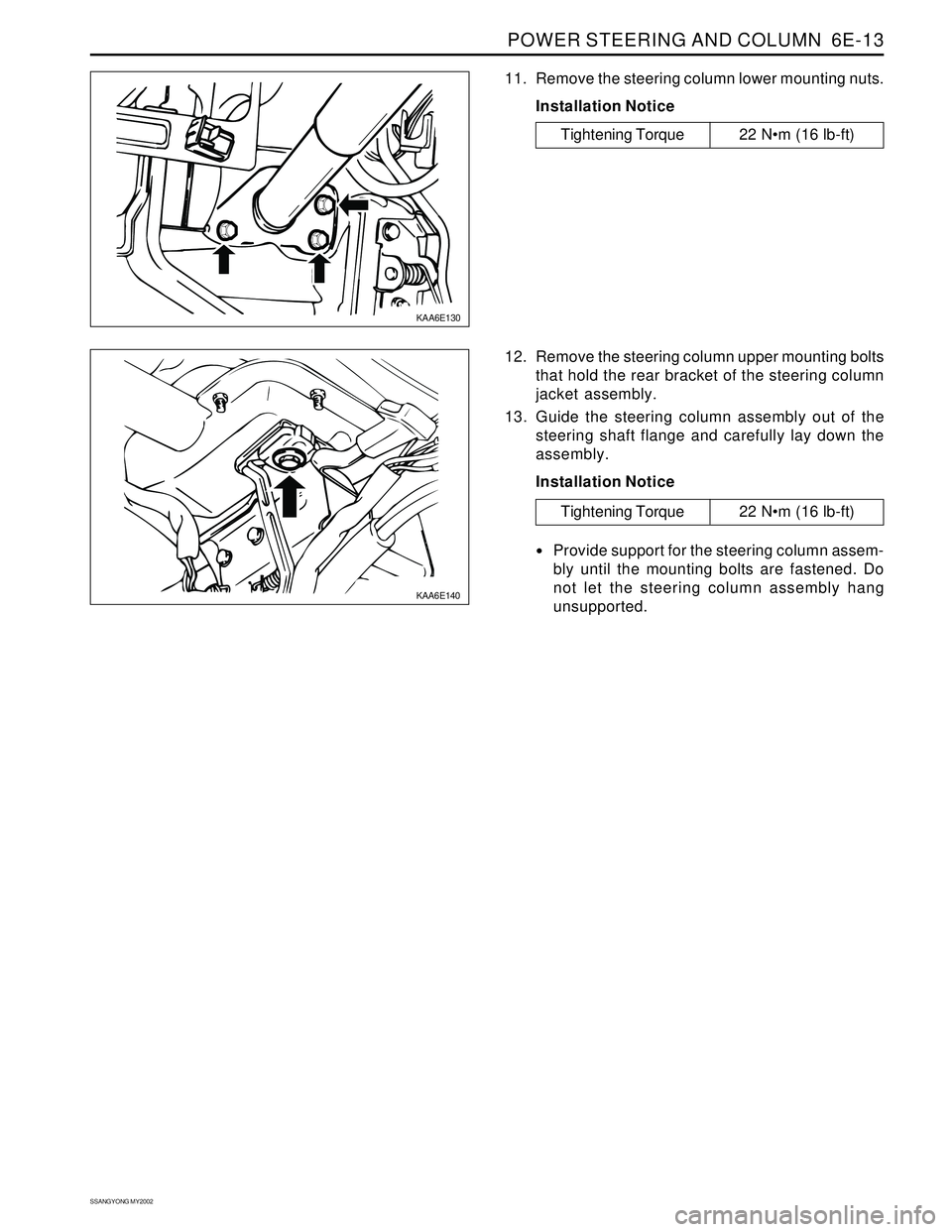
POWER STEERING AND COLUMN 6E-13
SSANGYONG MY2002
KAA6E130
11. Remove the steering column lower mounting nuts.
Installation Notice
KAA6E140
12. Remove the steering column upper mounting bolts
that hold the rear bracket of the steering column
jacket assembly.
13. Guide the steering column assembly out of the
steering shaft flange and carefully lay down the
assembly.
Installation Notice
Provide support for the steering column assem-
bly until the mounting bolts are fastened. Do
not let the steering column assembly hang
unsupported.
Tightening Torque 22 Nm (16 lb-ft)
Tightening Torque 22 Nm (16 lb-ft)
Page 1500 of 2053
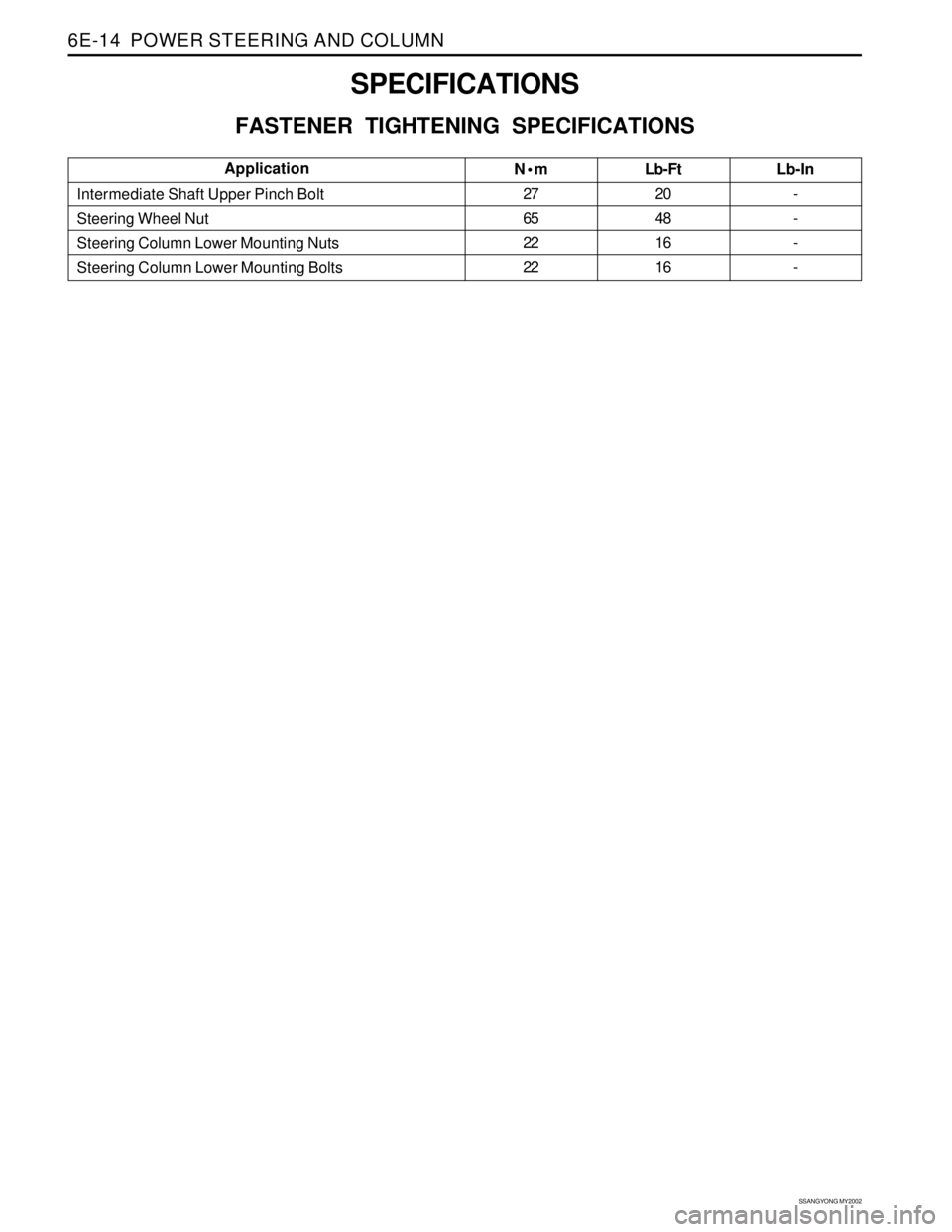
SSANGYONG MY2002
6E-14 POWER STEERING AND COLUMN
SPECIFICATIONS
FASTENER TIGHTENING SPECIFICATIONS
N•m
27
65
22
22Lb-Ft
20
48
16
16 Intermediate Shaft Upper Pinch Bolt
Steering Wheel Nut
Steering Column Lower Mounting Nuts
Steering Column Lower Mounting BoltsLb-In
-
-
-
-Application
Page 1501 of 2053
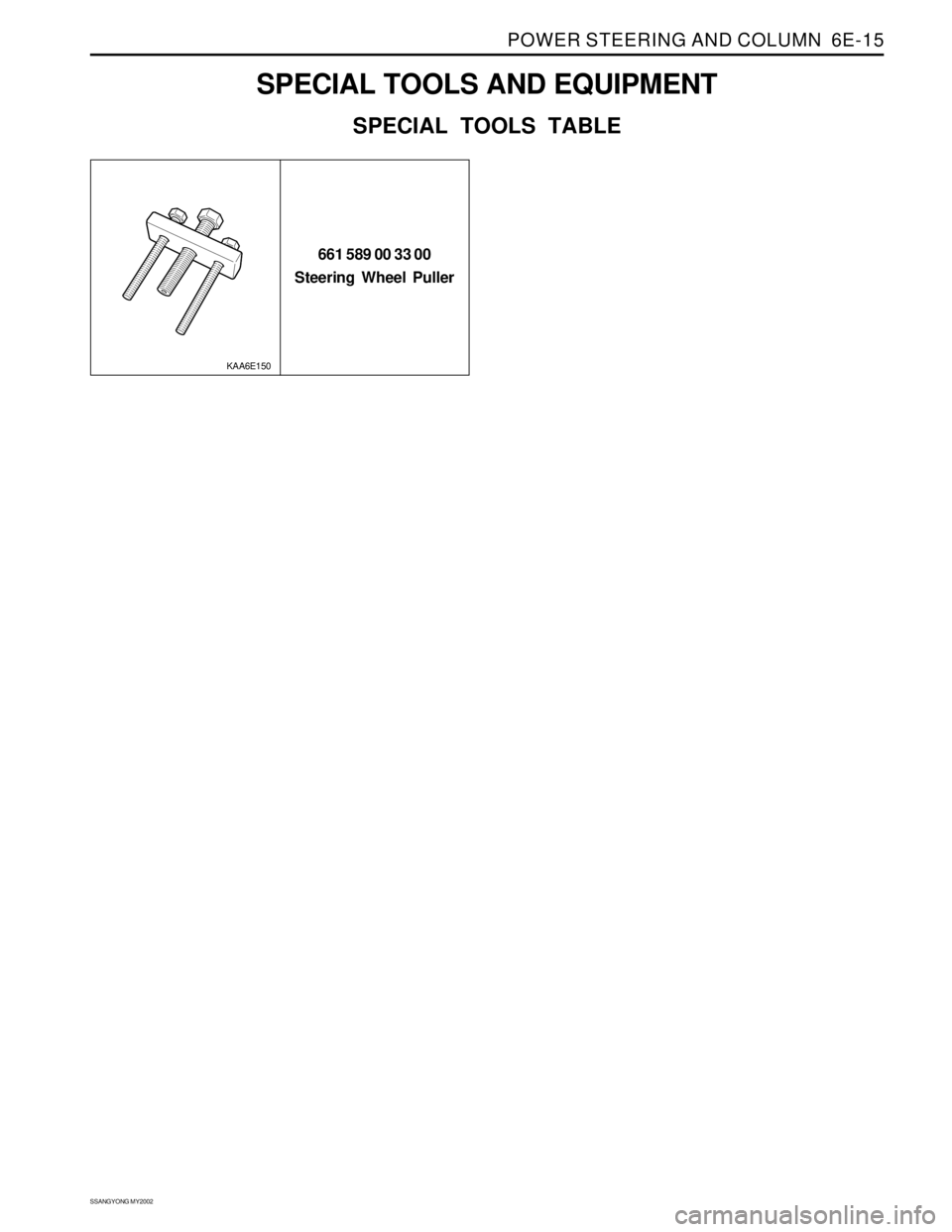
POWER STEERING AND COLUMN 6E-15
SSANGYONG MY2002
SPECIAL TOOLS AND EQUIPMENT
SPECIAL TOOLS TABLE
661 589 00 33 00
Steering Wheel Puller
KAA6E150
Page 1588 of 2053
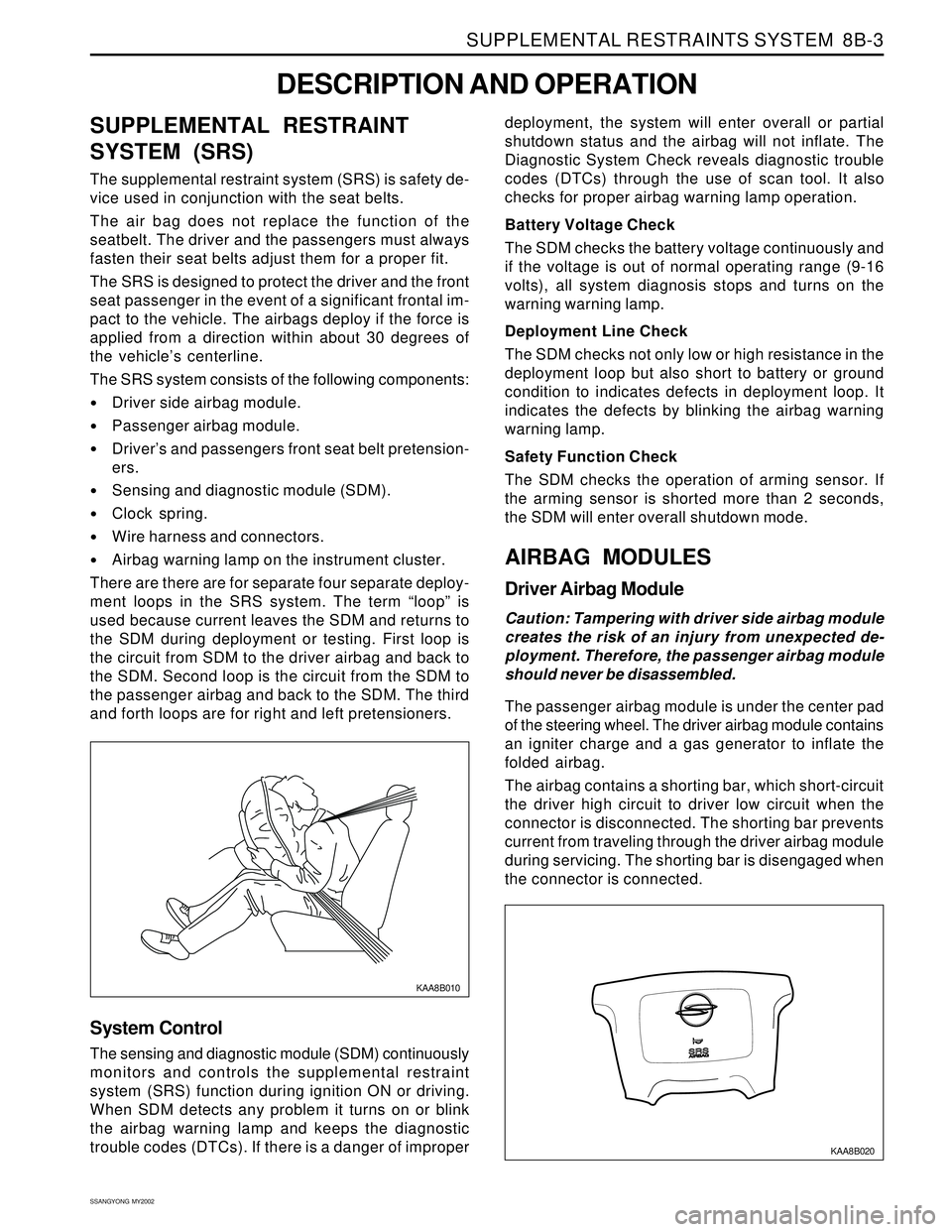
SUPPLEMENTAL RESTRAINTS SYSTEM 8B-3
SSANGYONG MY2002
SUPPLEMENTAL RESTRAINT
SYSTEM (SRS)
The supplemental restraint system (SRS) is safety de-
vice used in conjunction with the seat belts.
The air bag does not replace the function of the
seatbelt. The driver and the passengers must always
fasten their seat belts adjust them for a proper fit.
The SRS is designed to protect the driver and the front
seat passenger in the event of a significant frontal im-
pact to the vehicle. The airbags deploy if the force is
applied from a direction within about 30 degrees of
the vehicle’s centerline.
The SRS system consists of the following components:
Driver side airbag module.
Passenger airbag module.
Driver’s and passengers front seat belt pretension-
ers.
Sensing and diagnostic module (SDM).
Clock spring.
Wire harness and connectors.
Airbag warning lamp on the instrument cluster.
There are there are for separate four separate deploy-
ment loops in the SRS system. The term “loop” is
used because current leaves the SDM and returns to
the SDM during deployment or testing. First loop is
the circuit from SDM to the driver airbag and back to
the SDM. Second loop is the circuit from the SDM to
the passenger airbag and back to the SDM. The third
and forth loops are for right and left pretensioners.
DESCRIPTION AND OPERATION
KAA8B010
deployment, the system will enter overall or partial
shutdown status and the airbag will not inflate. The
Diagnostic System Check reveals diagnostic trouble
codes (DTCs) through the use of scan tool. It also
checks for proper airbag warning lamp operation.
Battery Voltage Check
The SDM checks the battery voltage continuously and
if the voltage is out of normal operating range (9-16
volts), all system diagnosis stops and turns on the
warning warning lamp.
Deployment Line Check
The SDM checks not only low or high resistance in the
deployment loop but also short to battery or ground
condition to indicates defects in deployment loop. It
indicates the defects by blinking the airbag warning
warning lamp.
Safety Function Check
The SDM checks the operation of arming sensor. If
the arming sensor is shorted more than 2 seconds,
the SDM will enter overall shutdown mode.
AIRBAG MODULES
Driver Airbag Module
Caution: Tampering with driver side airbag module
creates the risk of an injury from unexpected de-
ployment. Therefore, the passenger airbag module
should never be disassembled.
The passenger airbag module is under the center pad
of the steering wheel. The driver airbag module contains
an igniter charge and a gas generator to inflate the
folded airbag.
The airbag contains a shorting bar, which short-circuit
the driver high circuit to driver low circuit when the
connector is disconnected. The shorting bar prevents
current from traveling through the driver airbag module
during servicing. The shorting bar is disengaged when
the connector is connected.
System Control
The sensing and diagnostic module (SDM) continuously
monitors and controls the supplemental restraint
system (SRS) function during ignition ON or driving.
When SDM detects any problem it turns on or blink
the airbag warning lamp and keeps the diagnostic
trouble codes (DTCs). If there is a danger of improper
KAA8B020
Page 1590 of 2053
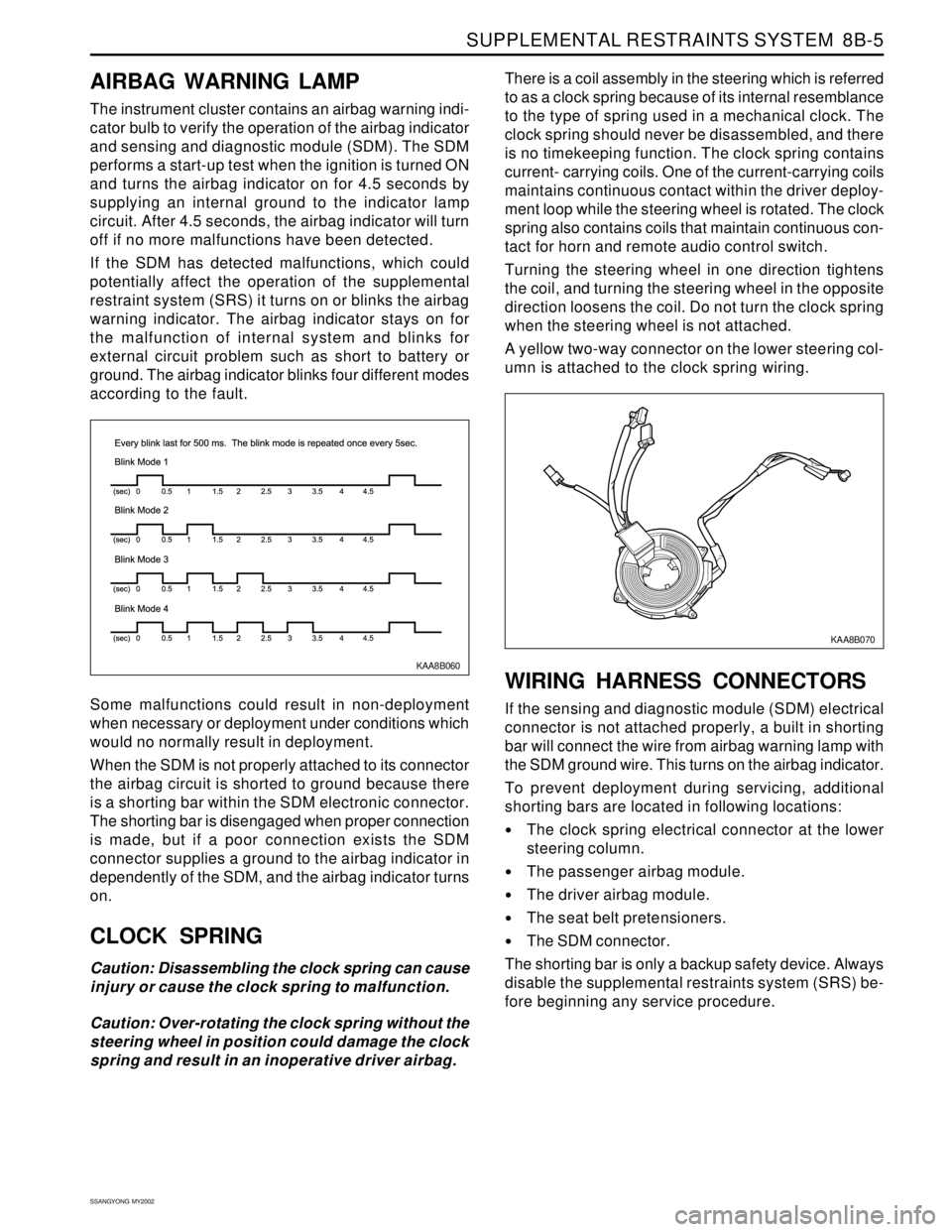
SUPPLEMENTAL RESTRAINTS SYSTEM 8B-5
SSANGYONG MY2002
KAA8B060
AIRBAG WARNING LAMP
The instrument cluster contains an airbag warning indi-
cator bulb to verify the operation of the airbag indicator
and sensing and diagnostic module (SDM). The SDM
performs a start-up test when the ignition is turned ON
and turns the airbag indicator on for 4.5 seconds by
supplying an internal ground to the indicator lamp
circuit. After 4.5 seconds, the airbag indicator will turn
off if no more malfunctions have been detected.
If the SDM has detected malfunctions, which could
potentially affect the operation of the supplemental
restraint system (SRS) it turns on or blinks the airbag
warning indicator. The airbag indicator stays on for
the malfunction of internal system and blinks for
external circuit problem such as short to battery or
ground. The airbag indicator blinks four different modes
according to the fault.
Some malfunctions could result in non-deployment
when necessary or deployment under conditions which
would no normally result in deployment.
When the SDM is not properly attached to its connector
the airbag circuit is shorted to ground because there
is a shorting bar within the SDM electronic connector.
The shorting bar is disengaged when proper connection
is made, but if a poor connection exists the SDM
connector supplies a ground to the airbag indicator in
dependently of the SDM, and the airbag indicator turns
on.
CLOCK SPRING
Caution: Disassembling the clock spring can cause
injury or cause the clock spring to malfunction.
Caution: Over-rotating the clock spring without the
steering wheel in position could damage the clock
spring and result in an inoperative driver airbag.There is a coil assembly in the steering which is referred
to as a clock spring because of its internal resemblance
to the type of spring used in a mechanical clock. The
clock spring should never be disassembled, and there
is no timekeeping function. The clock spring contains
current- carrying coils. One of the current-carrying coils
maintains continuous contact within the driver deploy-
ment loop while the steering wheel is rotated. The clock
spring also contains coils that maintain continuous con-
tact for horn and remote audio control switch.
Turning the steering wheel in one direction tightens
the coil, and turning the steering wheel in the opposite
direction loosens the coil. Do not turn the clock spring
when the steering wheel is not attached.
A yellow two-way connector on the lower steering col-
umn is attached to the clock spring wiring.
WIRING HARNESS CONNECTORS
If the sensing and diagnostic module (SDM) electrical
connector is not attached properly, a built in shorting
bar will connect the wire from airbag warning lamp with
the SDM ground wire. This turns on the airbag indicator.
To prevent deployment during servicing, additional
shorting bars are located in following locations:
The clock spring electrical connector at the lower
steering column.
The passenger airbag module.
The driver airbag module.
The seat belt pretensioners.
The SDM connector.
The shorting bar is only a backup safety device. Always
disable the supplemental restraints system (SRS) be-
fore beginning any service procedure.
KAA8B070
Page 1619 of 2053
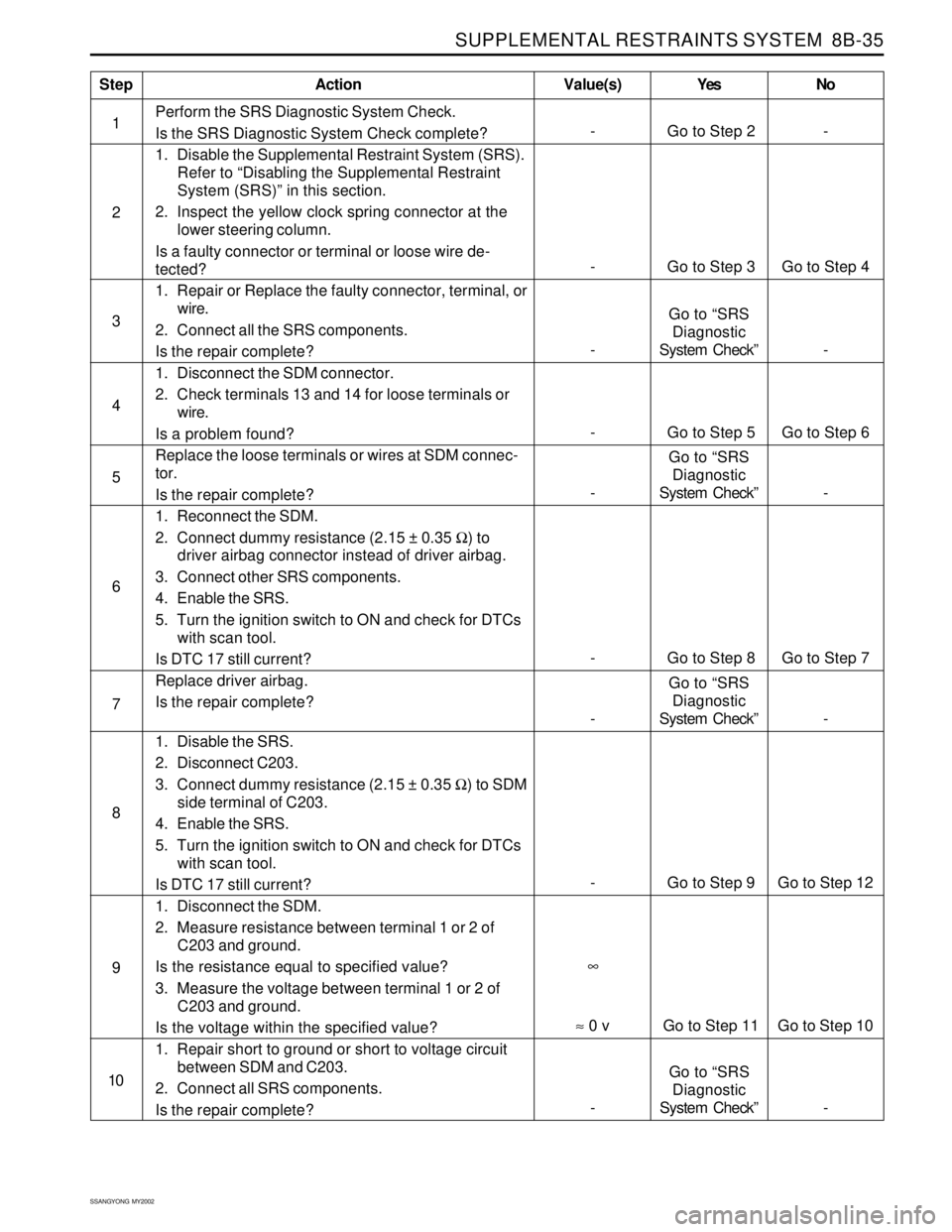
SUPPLEMENTAL RESTRAINTS SYSTEM 8B-35
SSANGYONG MY2002
Perform the SRS Diagnostic System Check.
Is the SRS Diagnostic System Check complete?
1. Disable the Supplemental Restraint System (SRS).
Refer to “Disabling the Supplemental Restraint
System (SRS)” in this section.
2. Inspect the yellow clock spring connector at the
lower steering column.
Is a faulty connector or terminal or loose wire de-
tected?
1. Repair or Replace the faulty connector, terminal, or
wire.
2. Connect all the SRS components.
Is the repair complete?
1. Disconnect the SDM connector.
2. Check terminals 13 and 14 for loose terminals or
wire.
Is a problem found?
Replace the loose terminals or wires at SDM connec-
tor.
Is the repair complete?
1. Reconnect the SDM.
2. Connect dummy resistance (2.15 ± 0.35 Ω) to
driver airbag connector instead of driver airbag.
3. Connect other SRS components.
4. Enable the SRS.
5. Turn the ignition switch to ON and check for DTCs
with scan tool.
Is DTC 17 still current?
Replace driver airbag.
Is the repair complete?
1. Disable the SRS.
2. Disconnect C203.
3. Connect dummy resistance (2.15 ± 0.35 Ω) to SDM
side terminal of C203.
4. Enable the SRS.
5. Turn the ignition switch to ON and check for DTCs
with scan tool.
Is DTC 17 still current?
1. Disconnect the SDM.
2. Measure resistance between terminal 1 or 2 of
C203 and ground.
Is the resistance equal to specified value?
3. Measure the voltage between terminal 1 or 2 of
C203 and ground.
Is the voltage within the specified value?
1. Repair short to ground or short to voltage circuit
between SDM and C203.
2. Connect all SRS components.
Is the repair complete?
StepAction Value(s) Yes No
2
4
5
6
- Go to Step 3 Go to Step 4
3
-Go to “SRS
Diagnostic
System Check” -
- Go to Step 5 Go to Step 6
-Go to “SRS
Diagnostic
System Check” -
-Go to “SRS
Diagnostic
System Check” -
- Go to Step 9 Go to Step 12 7
8
9
10
-Go to “SRS
Diagnostic
System Check” - 1
- Go to Step 2 -
≈ 0 v Go to Step 11 Go to Step 10∞
- Go to Step 8 Go to Step 7